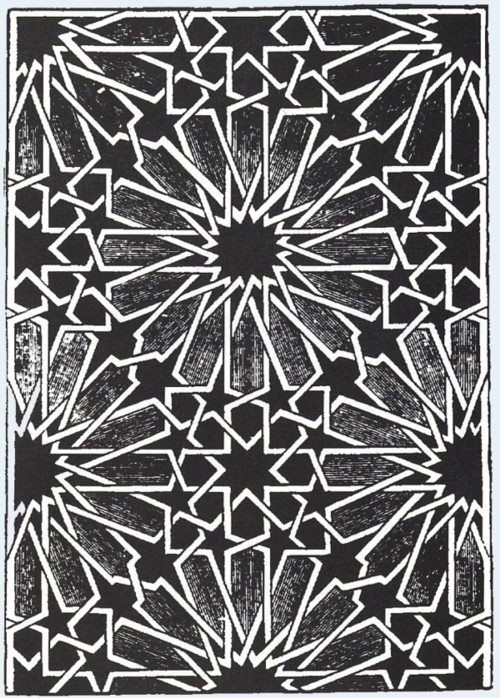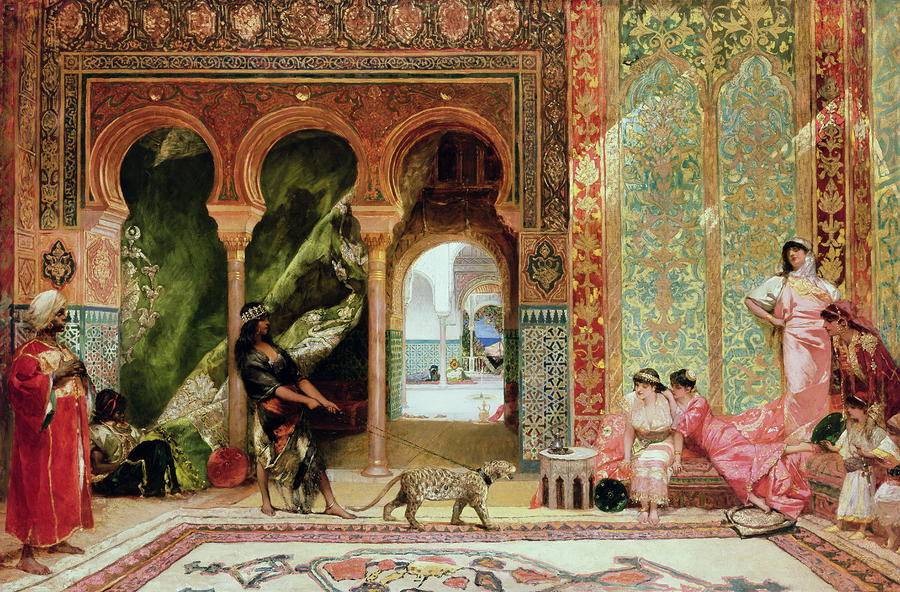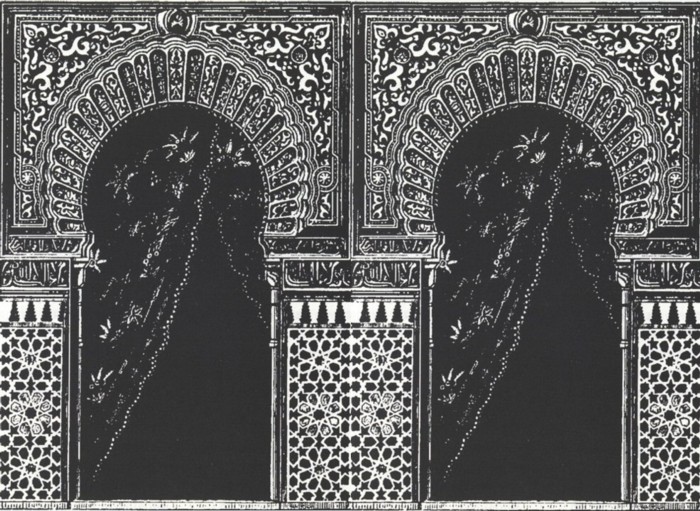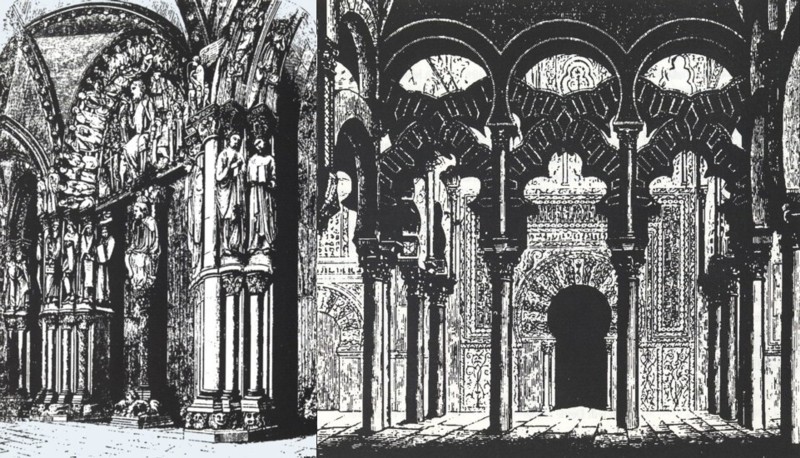:format(jpeg):mode_rgb():quality(90)/discogs-images/R-1054360-1188500781.jpeg.jpg)
medieval.org
Erdenklang 20562 "Cross Culture"
1992
I. Entrada [6:45]
II. Bells for the Virgin [6:03] CSM 256
based on textual and melodic fragments from Cantiga No. 256
[Quen na Virgen groriosa]
III. Maravillosos [3:26] CSM 139
based on textual and melodic fragments from Cantiga No. 139
[Maravillosos et piadosos]
IV. Guiding Star [9:34] CSM 49
based on Cantiga No. 49
[Ben com' aos que van por mar]
V. While the birds sing [7:22]
text by Ibn al-Khatíb (1313-1375)
based on melodic fragments from Arab oral tradition
[Umzuj]
VI. Deus ex machina [4:42] CSM 77
based on Cantiga No. 77
[Da que Deus mamou o leite do seu peito]
VII. He who loves you [4:33]
based on textual and melodic fragments from Moroccan oral tradition
[Man'habbak]
VIII. Miragre [4:57] CSM 32
based on textual and melodic fragments from Cantiga No. 32
[Quen loar podia]
IX. The Landlord / The Bearer of the Cups [6:43]
text by Ibn al-Zuhr (1313-1198)
based on melodic fragments from Arab oral tradition
[Ajuha]

VOX VOICES
Fadia El-Hage, Catherine Rey, Rose Bihler-Shah
VOX CHOIR (Choir Director: Rose Bihler-Shah)
Robert Altmöder, Simon Berg, Martin Fogt, Mike Frey, Roger Hefele,
Oliver Kälberer, Clemens Kink, Steffen Müller Rabbe, Thomas Näbauer,
Thomas Reichenbach, Walter Tröbinger, Gregor von der Heyden
VOX INSTRUMENTS
• Roman Bunka, ud [solos on I./V./VII./IX.], electric guitars [IV.], acoustic guitars
• Paolo Giuseppe Cecere, vielle, symphonia, al-anfir (medieval arab trumpet), shawm, voice [intro on IV.]
• Marika Falk, ethnic percussion (african & arab vase drums, latin & african percussion, water drums, berimbau)
• Vladimir Ivanoff, analog & digital synthesizers, sampling modules, sequencer programming, medieval organ, medieval and arab frame drums, santur, medieval lute
• Walter Weh, flute [V.], MIDI-sax [IX.]
Recording and Mix: January 1992, Jochen Scheffter, Downtown Studio München
Mastering: February 1992, W. Meyscheider, Studio Ulrich Kraus, Musikhochschule München
Producers: Vladimir Ivanoff / Ulrich Rützel
Cover Design: Dorothea Ritter
[Based on a detail from the painting The Pet Leopard by J.-J. Benjamin-Constant, 1845-1902]
With kind permission of Art Resource, N.Y.
Published by Erdenklang Musikverlag
From the CROSS CULTURE Music Collection
℗ + © 1992 by Erdenklang Musikverlag
Ulrich Rützel
Erdenklang
The Eclectic-Music Company
English liner notes

Von Spanien nach Spanien:
Musik,
die Geschichten erzählt und selbst Geschichte ist. Ströme verschiedener
Musikkulturen, die sich an verschiedenen historischen und
geographischen Orten vereinigten und dann wieder - getrieben vom Strom
der Geschichte - auseinander fließen mußten.
Eine musikalische
Odyssee durch Spanien, Afrika und Südamerika ist mit einer Zeitreise
durch die Jahrhunderte verbunden. Mittelalterliche spanische Cantigas
und alte europäische und arabische Musikinstrumente werden folienartig
von elektrischem Rai aus Marokko, südamerikanischen Rhythmen und
elektronischen Klängen überlagert. Musikgeschichte simultan: die Musik
von drei Kontinenten und die Geschichte der spanischen Musik vereinigen
sich zu einem simultanen Erleben verschiedener Kulturen und Zeiten.
I. Entrada
Das
Jahr 711 - eine neue Religion, eine neue geistliche und geistige Kraft
dringt nach Europa, in das spanische Westgotenreich ein: der Islam. Die
Araber bringen Krieg und Zerstörung - keine Neuigkeit für Europa. Sie
bringen aber auch Neues oder in Europa seit langem Vergessenes:
griechische Philosophie, Heilkunde, Kunst und Architektur, eine
Musiktheorie, welche die europäische Musikgeschichte revolutioniert, und
Musikinstrumente, aus denen sich die Mehrzahl der europäischen
Musikinstrumente entwickelnwird.
Die mit dem Recht freier
Glaubens-ausübung in den arabischen Kalifaten lebenden Christen nehmen
Elemente des islamischen Koranvortrags in ihren liturgischen Gesang auf
und schaffen den mozarabischen Choral. Der Lautenist Ziryáb flieht im 9.
Jahrhundert wegen einer Auseinandersetzung mit seinem Lehrer von Bagdad
nach Córdoba und begründet dort die arabo-andalusische Musiktradition.
An den arabischen Höfen von Córdoba und Granada dichten und musizieren
Künstler aus Orient und Okzident.
II. Glocken für die Jungfrau
Im
Jahre 1031 zerfällt das Kalifat von Córdoba in einzelne kleine
Königreiche. Das arabische Feindbild ist die Quelle eines neuen,
gegenläufigen Kraftstroms: aus der ständigen Fehde zwischen spanischen
Fürsten entwickelt sich ein Zusammenhalt der christlichen matamoros -
Maurentöter. Die spanischen Christen des Nordens leiten im Namen der
Jungfrau und der Heiligen eine Offensive ein, die das gesamte künftige
Weltbild verändernwird. König Ferdinand I. von Kastilien erobert im 11.
Jh. León. Sein Sohn, Alfons VI. dringt 1082 bis nach Gibraltar vor und
gewinnt drei Jahre später Toledo. Ein Glücksritter aus Burgos, Rodrigo
Diaz, genannt „El Cid", kämpft als Söldner abwechselnd auf arabischer
und christlicher Seite und erobert 1094 Valencia. Denn: „Wer in die
Jungfrau seine ganze Hoffnung setzt, den wird sie gut beschützen."
III. Maravillosos
Der
Kraftstrom der katholischen Reconquista nährt neue Zentren der
europäischen Kultur: in den Klosterzentren Spaniens werden Geistliche
aus ganz Europa in den Künsten, den Wissenschaften und der Musik
ausgebildet. Im Scriptorium (Schreibstube) des Klosters Ripoll entstehen
im 10. und 11. Jh. Handschriften mit mozarabisch beeinflußten Hymnen
und Chorälen. Die 72 Säulen des Kreuzganges von San Cugat tragen zu
einem Viertel Tierdarstellungen, die aus der indischen Tradition stammen
und Symbole für verschiedene Tonhöhen sind. Die Sonnenstrahlen
fallenwährend eines Tagesablaufs auf die verschiedenen Säulenkapitelle
und zeigen so die Töne der Hymne für den Heiligen Cugat an. Das Kloster
Montserrat war seit seiner Gründung im 11. Jahrhundert ein kulturelles
Zentrum ersten Ranges; einige der Mönche dort hatten an weit entfernten
Universitäten wie Paris oder Bologna studiert. Einer von ihnen verfaßte
eine Musikhandschrift, in der kirchliche Tänze festgehalten sind.
IV. Leistern
In
Jaffa wurde im ersten Jahrhundert Jakob geboren. Jacob - Jago -
Santiago ging nach Spanien, um dort zu predigen. Später kehrte er nach
Jerusalem zurück. Ein Jahrzehnt nach dem Tode Jesu wurde er von Herodes
Agrippa geköpft. Seinen Leichnam brachte man nach Spanien und begrub ihn
dort. Im 9. Jahrhundert entdeckte ein Eremit das Grab, von dem, wie
gesagt wird, ein Lichtschein ausging. Heute nennt man diesen Ort St.
Jakob im Sternenfeld: Santiago de Compostela. Pilger aus ganz Europa
gingen und ritten im Laufe der Jahrhunderte über den Camino de Santiago,
den Weg nach Santiago. Zahlreiche Abenteuer widerfuhren ihnen dort,
darunter viele mystische Erscheinungen und Wunder.
Etwa 400 dieser
Wunder wurden von Alfons X., dem Weisen, in den Cantigas de Santa Maria
gesammelt. Alfonso el Sabio versammelte maurische Gelehrte, Dichter und
Sänger, aber auch die provenzalischen Troubadours um sich; denn sein
größter Wunsch war es - wie er in der Widmung der Cantigas-Handschrift
schreibt - daß die Mutter Gottes ihn als ihren Troubadour erhört. Alfons
regierte von 1252 bis zu seinem Tod im Jahre 1284. In dieser Zeit
förderte er in beispielhafter Weise Musik und Musiker, Dichter,
Gelehrte, Astronomen, Künstler und Philosophen. Alfons' Hofhaltung in
Barcelona und Toledo war ein Ort, an dem Spielleute und Poeten, jüdische
und maurische Barde und Geschichtenerzähler, Troubadours aus Frankreich
und dem Deutsçhen Reich zusammentrafen. In den Cantigas trifft
Christliches und Maurisches zusammen: Dichtungen in Form des arabischen
zejel, mit orientalischem Musikinstrumenten ausgeführt, stoßen auf
lateinische Choräle römischer Tradition. In den Cantigas de Santa Maria
finden wir den Nucleus des Schmelztiegels, den man spanische Musik
nennt: jüdische Lieder, die musikalischen Spuren der arabischen
Eroberer, den Flamenco und vieles mehr. Der Leitstern des Hlgn. Jacob
führte zahllose Menschen auf den Weg zum Sternenfeld. Ihre Wanderungen,
festgehalten in den Cantigas und den Reliefs über den Portalen der
zahllosen Kirchen auf dem Jacobsweg definieren für die westliche Welt
bis heute den Begriff des Reisens.
V. Wenn die Vögel singen
Granada
ist im 15. Jahrhundert die wohlhabendste Stadt Spaniens. Trotz der
ständig wachsenden Bedrohung durch die christlichen Könige blüht dort
der Handel und damit auch Architektur, Literatur, Naturwissenschaften
und die Musik. In den letzten Tagen des Maurenreiches genießt man in der
Alhambra das Leben in vollen Zügen. Die rauhen Krieger der
afrikanischen Berge hatten sich zu Dichtern, Gelehrten und Künstlern
entwickelt. Das Innere des Alhambra-Palasts ist in Stein geformte Musik.
Wie in der arabo=andalusischen Kunstmusik, der núba, pflanzen sich
Ornamente auf dem leichtgewichtigen Baumaterial scheinbar endlos fort.
Zypressen, Orangenbäumejasmin und Myrtensträucher durchdringen den
ganzen Palast mit verschiedenen Düften. Das überall in Brunnen
gegenwärtige Wasser ist für die ehemaligen Wüstenbewohner der
wertvollste Bestandteil von allen. Es dient gleichzeitig als Augenweide
und als Ohrenschmaus. Vom duftendenWindhauch, dem Plätschern des Wassers
und dem Gesang der Vögel handelt auch die Poesie des araboandalusischen
Kunstlieds, der muwaššah.
VI. Deus ex machina
machina: lateinisch für „Belagerungsmaschine / Gerüst zur Ausstellung verkäuflicher Sklaven."
Durch
die Heirat von Isabella und Ferdinand werden 1469 Kastilien und Aragon
zusammengeschlossen. Die Vermählung von Machtpolitik, Glaubenseifer und
Naturwissenschaft ist die Quelle eines neuen Kraftstroms. Er spült im
Jahre 1492 die spanischen Juden und Muslime aus Europa und läßt in
seiner Flutwelle Kolumbus Amerika entdecken. Los Reyes Católicos- die
Katholischen Könige - schaffen den Gott aus der Maschine: Hölzerne
Maschinen belagern das arabische Granada, auf hölzernen Maschinen werden
von der Inquisition Juden, Araber und Häretiker abgeschlachtet, auf
hölzernen Maschinen reisend entdeckt man die Neue Welt, und auf
hölzernen Maschinen werden die amerikanischen Indianer als Sklaven
verkauft. Die Neuzeit hat begonnen.
VII. Der Dich liebt
Mit
dem Exodus von Juden und Arabern und der spanischen Kolonisation werden
viele Elemente der spanischen Kultur, der iberischen Musik, über das
Mittelmeer nach Afrika und den Atlantik nach Amerika getragen. Die Musik
der maurischen Eroberer, die sich in den vergangenen Jahrhunderten mit
anderen Musikstilen Spaniens vermengt hatte, war schon von Anfang an mit
musikalischen Elementen aus dem Westsudan und Südafrika durchsetzt. In
Amerika verschmolz in den folgenden Jahrhunderten die Musik von drei
Kontinenten: Europa - Afrika - Neue Welt.
VIII. Miragre
Auch
die Maschinerie des spanischen Katholizismus war kein dauernd währendes
Wundermittel. Die Neue Welt, lange Zeit unter dem Einfluß katholischen
Kolonisationsgeistes, nahm die fremden. kulturellen und politischen
Strömungen in sich auf, ließ ein kulturelles Amalgam entstehen, welches
heute den früher allgegenwärtigen spätmittelalterlichen christlichen
Geist welt in den Hintergrund treten läßt. Musikalische Weltherrschaft
hat heute die Strömung afro-amerikanischer Rhythmen, die früher
lernwillige Stiefkinder der europäischen Kolonisation waren.
IX. Träger der Kelche
Der
Geist des Mittelalters, der Traum einer Zivilisation in der drei
Weltreligionen friedlich miteinander leben können, ist nie ganz
untergegangen. Seien es die Nachkommen der aus Spanien vertriebenen
sephardischen Juden in Salt Lake City oder Nordafrika oder die
Abkömmlinge der arabo-andalusischen Mischkultur im heutigen Spanien; in
kleinen Wirtshäusern und Tavernen in vielen verschiedenen Ländern singt
man noch heute ein Trinklied mit arabischspanisch-jüdischem Text. Der
Wirt, den die durstigen Trinker um noch einen Becher Wein anflehen, kann
Gott, Jehova oder Allah sein; der Becher Wein, den der Wirt nur
widerwillig ausschenkt, ist die kleine Spanne von Leben, welche alle
Menschen sich zu dem ihnen angewiesenen Maß hinzu ersehnen.
© 1992 Dr. Vladimir Ivanoff
Music
which relates stories and is itself history. Currents of various music
cultures which converged at different historical and geographical points
and then - driven by the course of history - had to drift apart again.
A
musical Odyssee through Spain, Africa and South America is bound up
with a journey in time through the centuries. Mediaeval Spanish cantigas
and old European and Arabic musical instruments are foil-like overlain
by the electric rai from Morocco, South ~ American rhythms and
electronic sounds. Simultaneous music history: the music of three
continents and the history of Spanish music blend into a simultaneous
experience of varied cultures and time.
I. Entrada
The
year 711 - a new religion, a new spiritual and intellectual force,
pushes its way into Europe, into the Spanish realm of the Western Goths :
Islam. The Arabs bring with them war and destruction - nothing new for
Europe. But they also bring something new, or long since forgotten, in
Europe: Greek philosophy, medicine, art and architecture, a music theory
which revolutionises European music history, and musical instruments
from which the majority of European instruments will evolve. Christians
living in the Arab caliphates and quite freely practising their
religious beliefs, take over elements of Islamic Koran reading in their
liturgical vocal style and develop Mozarabic singing. Following a
dispute with his teacher, the flute player Ziryáb flies in the 9th
century from Baghdad to Córdoba and establishes the Arabo-Andalusian
music tradition. Artists from the Orient and Occident write poems and
make music at the Arab courts of Córdoba and Granada.
II. Bells for the Virgin
In
the year 1031 the caliphate of Córdoba degenerated into small
independent kingdoms. The concept of the Arab as an enemy is the source
of a new, counter-moving power potential: the constant feuding among the
pettry Spanish princelings develops into cohesion of the Christian matamoros
= Moorkillers. In the name of the Holy Virgin and of the saints, the
Spanish Christians of the North launched an offensive which was to
change entirely the future conception of the world. King Ferdinand I of
Castile in the 11th century conquered León. In 1082 his son Alfonso VI
advanced to Gibraltar, and three years later captured Toledo. An
adventurer from Burgos, Rodrigo Diaz, called "El Cid", fought as a
mercenary alternately on the Arab and Christian side, and in 1094
conquered Valencia. For: "He who places all his hope in the Virgin shall
enjoy her good protection."
III. Maravillosos
The
impetus of the Catholic Reconquista nourished new centres of European
culture. In Spain'ss monastery regions priests from all over Europe were
trained in the arts, the sciences and music. In the scriptorium
(writing room) of Ripoll monastery handwritten documents were produced
in the 10th and 11th centuries with Mozarabic influenced hymns and
plainsong. A quarter of the 72 pillars of the San Cugat cloister bear
depictions of animals originating from the Indian tradition, and are
symbols for various tonal pitches. In the course of a day the sun's rays
shine on the various pillar capitals and indicate the notes of the hymn
to Saint Cugat. Since its foundation in the 11th century the monastery
of Montserrat was a cultural centre of the highest order, some of the
monks there had studied in far distant universities, such as Paris or
Bologna. One of them produced a music manuscript documenting church
dances.
IV. The Guiding Star
Jacob was born in Jaffa in
the first century. Jacob - Jago - Santiago went to Spain to preach.
Later he returned to Jerusalem. One century after the death of Jesus he
was beheaded by Herodes Agrippa. His body was taken to Spain and buried
there. In the 9th century a hermit discovered the grave, which was said
to give off a gleam of light. Today this place is called St. Jacob in
the Field of Stars: Santiago de Compostela. Throughout the centuries
pilgrims from all over Europe walked and rode over the Camino de Santiago,
the path to Santiago. They experienced many adventures there, including
mystical visions and miracles. About 400 of these miracles were
collected by Alfonso X the Wise in the "Cantigas de Santa Maria".
Alfonso the Wise gathered about him Moorish scholars, poets and singers,
as well as the troubadours from Provence. As he wrote in the dedication
of the Cantigas Manuscript, his greatest wish was that the Mother of
God should hear him as her troubadour. Alfonso reigned from 1252 until
his death in 1284. During this period he encouraged in an exemplary
manner music and musicians, poets, scholars, astronomers, artists and
philosophers. Barcelona and Toledo, where Alfonso held court, were
gathering points for actors and poets, Jewish and Moorish bards and
storytellers, troubadours from France and the German realm. The songs of
the wise king tell of events along the pilgrims' path. To a major
extent the places still exist where all this happened, and are still
visited down to the present day. Christian and Moorish elements meet in
the Cantigas, poetry in the style of the zejel, recited to oriental
instruments, confronts Latin plainsong in the Roman tradition. In the
Cantigas de Santa Maria we discover the nucleus of the melting-pot which
is called Spanish music: Jewish songs, the musical traces of the Arab
conquerors, the flamenco and a great deal more. The guiding star of
Saint Jacob led countless people on the path to the field of stars. Their
wanderings, set down in the Cantigas and reliefs above the portals of
innumerable churches on the path to Jacob to the present time define for
the Western world the essence of travel.
V. While the birds sing
In
the 15th century Granada is Spain's most prosperous city. Despite the
constantly growing threat from the Christian kings, trade is flourishing
there, and with it also architecture, literature, the natural sciences
and music. In the last days of the Moorish realm life in the Alhambra is
being enjoyed to the full. The rough warriors of the African mountains
had developed into poets, scholars and artists. The interior of the
Alhambra palace is music shaped in stone. As in Arabo-Andalusian art
music, the núba, the ornaments on the lightweight building
material, proliferate in a seemingly endless process. Cypresses, orange
trees, jasmin and myrrh bushes permeate the whole palace with various
scents. For the former desert dwellers the most important aspect of all
is that water in fountains was present everywhere. It is simultaneously a
feast for the eyes and a delight for the ears. The scented breath of
air, splashing of the water and the singing of the birds are also
referred to in the poetry of the Arabo-Andalusian art song, the muwaššah.
VI. Deus ex machina
machina: Latin for "besieging machine / Platform for displaying slaves for sale."
As
a result of the marriage of Isabella and Ferdinand, Castile and Aragon
amalgamate in 1469. The marriage of power politics, religious zeal and
natural science is the source of yet another new impetus. In 1492 it
washes away the Spanish Jews and Muslims from Europe, and in its tidal
wave enable Columbus to discover America. Los ReyesCatólicos -
the Catholic kings - create god from the machine: timber contraptions
besiege Arab Granada, the Inquisition slaughter Jews, Arabs and heretics
on wooden instruments of torture, the New World is discovered with the
help of timber ships and on wooden platforms American Indians are sold
as slaves. The modern age has begun.
VII. He who loves you
With
the exodus of Jews and Arabs, and Spanish colonisation, many elements
of Spanish culture, of Iberian music, are borne across the Mediterranean
to Africa and the Atlantic to America. The music of the Moorish
conquerors, which in the preceding centuries had fused with other music
styles of Spain, had from the very outset been interspersed with musical
elements from West Sudan and South Africa. In America in the succeeding
centuries the music of three continents blended: Europe, Africa and the
New World.
VIII. Miragre
Nor was the machinery of
Spanish Catholicism an enduring magic potion. The New world, for a long
period under the influence of Catholic colonisation spirit, soaked up
the alien cultural and political currents and let a cultural amalgam
come about which today pushes way into the background the formerly
omnipresent late Middle Ages Christian spirit. Musical world domination
today is held by the current of Afro-American rhythms, which were
previously the eager-to-learn stepchildren of European colonisation.
IX. The Landlord / The Bearer of the Cups
The
spirit of the Middle Ages, the dream of a civilisation in which the
three world religions can live in peace with each other, has never been
entirely abandoned. Whether it is descendants of the SephardicJews
driven out of Spain and now in Salt Lake City or North Africa, or the
progeny of Arabo-Andalusian mixed culture in present-day Spain: in
little wine bars and taverns in many different countries a drinking
songs is still sung today with an Arab-Spanish Jewish text. The
landlord, to whom the thirsty drinkers plead for another glass of wine,
can be God, Jehovah or Allah. The cup of wine, which the innkeeper only
reluctantly pours out, is the little span of life which everybody yearns
for in addition to his allotted time.
©1992 Dr. Vladímir Ivanoff
english translation: Frederick A. Bishop

